


In spite of the uncertainties described above in the identification of the best solution for the SFH, the synthetic CMD method is extremely powerful in reducing the range of acceptable scenarios, i.e. the range of values of the various parameters. As demonstrated every time different synthetic CMD procedures have been applied to the same galaxy region, all the solutions come out consistent with each other (see e.g. the Coimbra experiment on the LMC bar [50], and IC1613 [64]). We can therefore dare drawing some general conclusions from the results obtained so far with this method.
Since the dawn of its application, the method immediately proved its power. First, it was found that the SFH differs significantly from one galactic region to the other even in tiny systems such as WLM, the first dwarf irregular (dIrr) in the Local Group to which the method was applied [30]. As soon as a few other nearby irregulars were studied, it turned out that, contrary to the common belief of the time, the SF activity in late-type dwarfs within the lookback time spanned by the available photometry has occurred in long episodes of moderate intensity, separated by short quiescent phases, rather than in short episodes of strong intensity, separated by long quiescent intervals [31, 33, 34, 35, 66]. In other words a gasping [34] rather than a bursting regime.
Nowadays, one can resolve individual faint/old stars in galaxies of the LG and its immediate vicinities, and infer their SFHs over long lookback times. In the (still few) cases when the oldest MSTO is reached, the SFH can be derived over the entire Hubble time, as already achieved in some regions of the LMC [43, 62, 67, 68, 69, 70], of the SMC [71, 72, 27] and in Leo A [65]. As an example, Fig. 15 shows the CMD obtained by [65] from ACS imaging of the dIrr Leo A, located at 800 kpc from us [52], and the resulting SFH. In Leo A the star formation activity was present, although quite low, at the earliest epochs, and 90% of the activity occurred in the last 8 Gyr, with the main peak around 2 Gyr ago and a secondary peak a few hundreds Myr ago. This SFH is very similar to that of fields in the LMC, SMC, IC1613 [73] and other late-type galaxies and we can consider it typical of dIrrs: a rather continuous star formation since the earliest epochs, but with significant peaks and gasps. Notice that the main SFR peak in dIrrs rarely occurs at the most recent epochs.
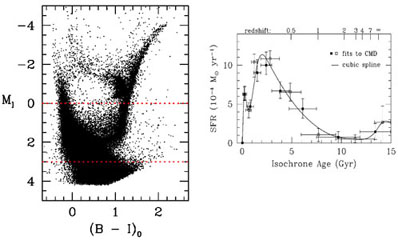 |
Figure 15. CMD and SFH of Leo A as derived by [65] from HST/ACS data. Notice the impressive depth and tightness of the CMD, allowing to infer the SFH even at the earliest epochs. Courtesy A. Cole. |
The high spatial resolution of HST cameras also allows to spatially resolve the SF activity, at least within relatively recent epochs. For instance, [74] and [75] have measured the SF activity over the last 0.5 Gyr in all the sub-regions of the dIrrs Gr8 and Sextans A, close to the borders of the LG. The resulting space and time distribution of the SF, with lightening and fading of adjacent cells, once again shows a gasping regime, and is intriguingly reminiscent of the predictions of the stochastic self-propagating SF theory proposed by [76] almost 30 years ago.
In the Magellanic Clouds, the conditions are clearly optimal, thanks to their proximity. Fig. 16 displays the SFH of the ACS field centered on the very young cluster NGC602 in the Wing of the SMC. It shows that the cluster has formed most of its stars around 2.5 Myr ago, while the surrounding field has formed stars continuously since the earliest epochs. All the studies on the MC fields have found that the SFHs of their different regions differ from one another in the details (e.g. epoch of activity peaks, enrichment history, etc.) but are always characterized by a gasping regime. In the LMC a clear difference has been found between the SFH of field stars and of star clusters, the latter showing a long quiescence phase absent in the field. This difference is not found in the SMC.
 |
Figure 16. SFH of the ACS field centered on the SMC young cluster NGC602 as derived by [27]. The oldest part of the SFH is zoomed-in in the upper right inset. The ACS image and the CMD of the field are shown in the left-hand panels of Fig. 2. |
To find SFHs peaked at earlier epochs one needs to look at early-type dwarfs: dwarf ellipticals (dEs), dSphs and even transition-type dwarfs clearly underwent their major activity around or beyond 10 Gyr ago [73]. The latter also have significat activity at recent epochs (e.g. [77]). The former have few (or no) episodes of moderate activity in the last several Gyrs (e.g. [78, 79, 40, 80, 52, 81]). A beautiful example of CMDs and SFH of a dSph is shown in Fig. 17. It is the Cetus dSph, observed with HST/ACS by the L-CID group [82] and to be published by Monelli et al. (in preparation). Here the SF activity in the last several Gyrs is negligible and the strongest peak occurred about 11 Gyr ago (interestingly, not at the earliest epoch, though).
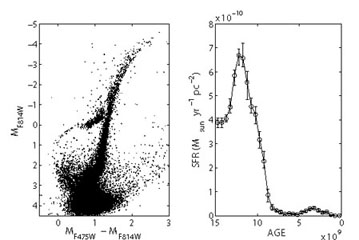 |
Figure 17. CMD and SFH of Cetus as derived by Monelli et al. (in preparation) from HST/ACS data in the framework of the L-CID project [82]. Notice again the impressive depth and tightness of the CMD, allowing to infer the SFH even at the earliest epochs. Courtesy M. Monelli and C. Gallart. |
To date, a large fraction of LG galaxies have been studied to infer the SFH of at least some of their regions with the synthetic CMD method (see [83, 18] and references therein, for updated reviews): the two spirals, M31 and M33, the two Magellanic Clouds, a dozen dIrrs, 5 transition type dwarfs and about 20 early-type dwarfs (dwarf spheroidals and dwarf ellipticals). In some of these fields the photometry has allowed to reach the oldest MSTO, in others the HB, i.e. the unmistakable signature of SF activity earlier than 10 Gyr ago (e.g. [84, 85, 86]). Attention is being payed [87] also to the ultra-faint dwarfs (uFds) recently discovered by the Sloan Digital Sky Survey around the Milky Way (e.g. [88]), for their interest as possible Galactic building blocks. Additional efforts by various groups are in progress to obtain deeper and more accurate photometry in these and other galaxies and derive reliable SFHs over longer lookback times. For instance, very interesting results are expected from the L-CID HST program [82] on the SFH of 6 LG dwarfs of different type (two dIrrs, two dSphs and two transition type) observed by the ACS with unprecedented depth and resolution.
In galaxies beyond the LG, distance makes crowding more severe, and even HST cannot resolve stars as faint as the MSTO of old populations. The higher the distance, the worse the crowding conditions, and the shorter the lookback time τ reachable even with the deepest, highest resolution photometry. Depending on distance and intrinsic crowding, the reachable lookback time in galaxies more than 1 Mpc away ranges from several Gyrs (in the best cases, when the RGB or even the HB are clearly identified), to several hundreds Myr (when AGB stars are recognized), to a few tens Myr (when only the brightest supergiants are resolved). The effect of distance on the possibility of resolving individual stars, and therefore on the reachable τ, is displayed in Fig. 18, where the CMDs of three late-type galaxies are shown, as resulting from WFPC2 photometry in equivalent observing conditions: the LMC bar [68], with a distance modulus of 18.47 (50 kpc) and a CMD reaching a few mags below the old MSTO; NGC1705 [91], with distance modulus 28.54 (5.1 Mpc) and a CMD reaching a few mags below the tip of the RGB; and IZw18 [92]), with the new distance modulus 31.3 (18 Mpc) derived by [89] and AGB stars being the faintest/older resolved stars.
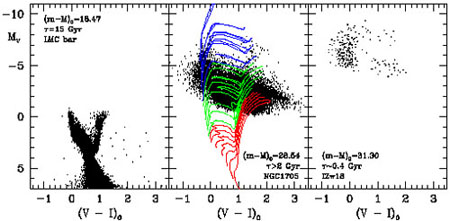 |
Figure 18. Effect of distance on the resolution of individual stars and on the corresponding lookback time τ for the SFH. CMD in absolute magnitude and colour of systems observed with the HST/WFPC2 and analysed with the same techniques, but at different distances; from left to right: 50 Kpc (LMC bar), 5.1 Mpc (NGC1705) and 18 Mpc (IZw18). The central panel also shows stellar evolution tracks from [23] for reference: red lines refer to low-mass stars, green lines to intermediate mass stars, and blue lines to massive stars. |
Notice that the new modulus of IZw18 is inferred from the periods and luminosities of a few classical Cepheids measured from ACS time-series photometry, which also allowed to obtain a much deeper CMD [89]. The WFPC2 data shown in Fig. 18 reach only the AGB, while the CMD obtained from the ACS (shown in Fig. 19 together with the ACS image) reaches below the tip of the RGB. Indeed, the unique performances of the ACS have allowed people to resolve individual stars on the RGB of some of the most metal-poor Blue Compact Dwarfs (BCDs), such as SBS 1415+437 at 13.6 Mpc [93] and IZw18 at 18 Mpc [89]. The discovery of stars several Gyrs old in these extremely metal-poor systems is a key information for galaxy formation and evolution studies. It has allowed to detect in BCDs population gradients, the central concentration of most of the SF activity, the existence of old, metal-poor halos (e.g. [94] and subsequent papers).
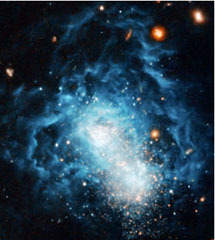 |
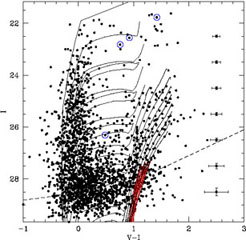 |
Figure 19. Image and CMD of I Zw 18, obtained from HST/ACS imaging [89]. Overimposed on the CMD are the Z = 0.0004 isochrones by [90] with the RGB in red. Also shown is the average position of the 4 classical Cepheids with reliable light-curves obtained from these data. Image credit: NASA, ESA and A. Aloisi (STScI, ESA). |
|
With an amazing success rate, the ACS has allowed people to resolve individual stars from the brightest and youngest to those as faint and old as the red giants in an increasing number of dwarfs outside the LG, in the distance range from 2 to 20 Mpc. This allows to study the SFH of isolated and interacting dwarfs. People are becoming able to compare the SFHs of LG dwarfs with those of other groups of galaxies, such as the M81 (e.g. [95]) and the IC342 (Grocholski et al. in preparation) groups. The resulting CMDs lead to the derivation of their SFHs over a lookback time of at least a few Gyrs and, often, to a more accurate estimate of their distance (e.g. [89, 96])
Only few groups have embarked in the more challenging application of the synthetic CMD method beyond the LG, and most of them have concentrated their efforts on starbursting late-type dwarfs [104, 97, 105, 92, 94, 102, 106, 101, 107, 99, 98, 103, 108]. However, HST (new observations and archive) is still providing a wealth of excellent images of external dwarfs. In particular, the ACS Nearby Galaxy Survey Treasury is promising an unprecedented data base for these purposes [109], and we can expect a flourishing of applications of the synthetic CMD method to many more galaxies beyond the LG boundaries in the near future.
All the studies performed so far have shown that all the examined galaxies were already active at the reached lookback time, including the BCDs that in the past had been suggested to be genuinely young galaxies, experiencing now their first episode of SF. All late-type dwarfs present a recent SF burst, which is what let people discover them in spite of the distance, and none of them exhibits long quiescent phases within the reached lookback time. On the other hand, the SFR differs significantly from one galaxy to the other.
These results can be visualized in Fig. 20, where some examples of SFH of external late-type dwarfs are given. All these SFHs have been derived with the synthetic CMD method applied to HST/WFPC2 or NICMOS photometry. The lookback time reached by the photometry is indicated by the thin vertical line in each panel, and in all cases stars of that age were detected. As shown by [100] for NGC 1705, the available data allow to rule out that these galaxies have had short-duration, intermediate-age bursts like the current one within the covered lookback time. The sample of displayed galaxies contains various types of dwarfs: UGC 5889 is a low surface brightness galaxy (LSB), NGC 1705, IZw18, IZw36 and Mrk178 are BCDs, while NGC 1569 is classified as dIrr. Nonetheless, they all show a qualitatively similar behavior: a stronger current burst overimposed on a moderate and rather continuous SF activity. Quantitatively, instead, the SFRs differ from each other by orders of magnitude.
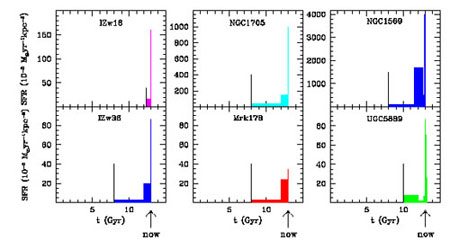 |
Figure 20. SFHs of late-type dwarfs outside the Local Group observed with WFPC2 or NICMOS. In all panels the SFR per unit area as a function of time is plotted. The thin vertical line indicates the lookback time reached by the adopted photometry. Notice that, for those galaxies that have been subsequently observed also with the ACS, the lookback time is actually quite older, and always with indisputable evidence of SF activity already in place. References: NGC 1569, [97, 98]; NGC 1705, [99, 100]; I Zw 18, [92]; I Zw 36, [101]; Mrk 178, [102]; UGC 5889, [103]. |
The general results drawn from all the SFHs derived so far from CMDs in and beyond the LG can be schematically summarized as follows: